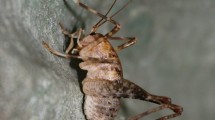Summary
The opercularis system (OPS) of amphibians consists of an opercularis muscle that connects the shoulder girdle skeleton to the operculum, a movable element in the oval window of the otic capsule. The role of the OPS in reception of vibrations was examined in bullfrogs (Rana catesbeiana) tested in various postures that manipulated differential motion between the shoulder girdle (the origin of the opercularis muscle) and skull (including the inner ear). Amplitude and phase relationship of motions of the suprascapular cartilage of the shoulder girdle and the posterior skull were also measured during these tests.
-
1.
Microphonic responses to vertical vibrations from 25–200 Hz were typically highest when frogs were in a normal, sitting posture with the head held off the vibrating platform. Responses from animals in which the head directly contacted the platform were often less (by up to 10 dB at certain frequencies). Responses from all test positions were highest at lower frequencies, especially between 50–100 Hz.
-
2.
Suprascapular accelerations were typically highest in the normal, sitting posture, and at lower frequencies (50–75 Hz) were often greater than that of the vibrating platform by up to 8 dB. The shoulder girdle skeleton of the bullfrog is therefore readily affected by vertical substrate motion.
-
3.
The amplitude of microphonic responses in the different test postures did not correspond well with head acceleration. Rather, response amplitude corresponded best with the absolute difference between shoulder and head motion. For example, in the normal posture, suprascapular motion was much greater than head motion, and responses were relatively high. If only the head was vibrated, head motion was high and shoulder motion low, and responses also were relatively high. If the head and body were vibrated together, their motions were similar, and responses to the same platform accelerations were often reduced. Phase differences between shoulder and head motions were small at the frequencies examined and may be of little functional significance. The importance of differences in shoulder and head motion suggests that the resulting differential motion of the operculum and inner ear fluids can produce waves that stimulate appropriate end organs (such as the saccule).
-
4.
Removal of the opercularis muscle reduced responses up to 18 dB at certain frequencies in some of the test postures. The most significant reductions were observed in those postures with a significant difference between shoulder and head motion (such as the normal posture). The opercularis muscle is therefore effective in translating differential motion of the head and shoulder into motion of the operculum relative to the inner ear fluids.
-
5.
Vertical vibrations produced higher microphonic responses than longitudinal or transverse vibrations of the same acceleration. Also, removal of the opercularis muscle produced a greater decrease in responses to vertical vibrations than in responses to the other types of vibrations. This suggests that the OPS of the bullfrog is specialized for reception of vertical substrate motions, such as Rayleigh waves, natural surface waves with a largely vertical energy component.
Similar content being viewed by others
Abbreviations
- OPS :
-
opercularis system
References
Aertsen AMHJ, Vlaming MSMG, Eggermont JJ, Johannesma PIM (1986) Directional hearing in the grassfrog (Rana temporaria L.). II. Acoustics and modelling of the auditory periphery. Hearing Res 21:17–40
Becker RP, Lombard RE (1977) Structural correlates of function in the ‘opercularis’ muscle of amphibians. Cell Tissue Res 175:499–522
Brownell PH (1977) Compressional and surface waves in sand: used by desert scorpions to locate prey. Science 197:479–482
Brownell PH, Farley RD (1979) Detection of vibrations in sand by tarsal sense organs of the nocturnal scorpion,Paruroctonus mesaensis. J Comp Physiol 131:23–30
Hetherington TE (1985) The role of the opercularis muscle in seismic sensitivity in the bullfrogRana catesbeiana. J Exp Zool 235:27–34
Hetherington TE (1987a) The opercularis system: an alternate pathway for sound reception in amphibians. Abstracts of the Tenth Midwinter Meeting of the Association for Research in Otolaryngology, pp 62–63
Hetherington TE (1987b) Physiological features of the opercularis muscle and their effects on vibratory sensitivity in the bullfrogRana catesbeiana. J Exp Biol 131:1–16
Hetherington TE, Lombard RE (1983) Electromyography of the opercularis muscle of the bullfrogRana catesbeiana: an amphibian tonic muscle. J Morphol 175:17–26
Hetherington TE, Jaslow AP, Lombard RE (1986) Comparative morphology of the amphibian opercularis muscle. I. General design features and functional interpretation. J Morphol 190:43–61
Kingsbury BF, Reed HD (1909) The columella auris in Amphibia. J Morphol 20:549–628
Koyama H, Lewis ER, Leverenz EL, Baird RA (1982) Acute seismic sensitivity in the bullfrog ear. Brain Res 250:168–172
Lewis ER, Narins PM (1985) Do frogs communicate with seismic signals? Science 227:187–189
Lewis ER, Baird RA, Leverenz EL, Koyama H (1982) Inner ear: dye injection reveals peripheral origin of specific sensitivities. Science 215:1641–1643
Lombard RE, Straughan IR (1974) Functional aspects of anuran middle ear structures. J Exp Biol 61:71–93
Moore WJ (1981) The mammalian skull. Cambridge University Press, Cambridge
Narins PM, Lewis ER (1985) The vertebrate ear as an exquisite seismic sensor. J Acoust Soc Am 76:1384–1387
Paton JA (1971) Microphonic potentials in the inner ear of the bullfrog. Masters dissertation, Cornell University
Tonndorf J (1972) Bone conduction. In: Tobias JV (ed) Foundation of modern auditory theory
Wever EG (1985) The amphibian ear. Princeton University Press, Princeton
Author information
Authors and Affiliations
Rights and permissions
About this article
Cite this article
Hetherington, T.E. Biomechanics of vibration reception in the bullfrog,Rana catesbeiana . J. Comp. Physiol. 163, 43–52 (1988). https://doi.org/10.1007/BF00611995
Accepted:
Issue Date:
DOI: https://doi.org/10.1007/BF00611995




